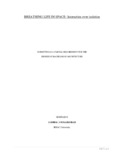| dc.contributor.author | Kaikobad, S M | |
| dc.date.accessioned | 2018-06-05T08:43:59Z | |
| dc.date.available | 2018-06-05T08:43:59Z | |
| dc.date.copyright | 2017 | |
| dc.date.issued | 2017 | |
| dc.identifier.other | ID 12108016 | |
| dc.identifier.uri | http://hdl.handle.net/10361/10263 | |
| dc.description | This thesis is submitted in partial fulfillment of the requirements for the degree of Bachelor of Architecture, 2017. | en_US |
| dc.description | Cataloged from PDF version of thesis. | |
| dc.description | Includes bibliographical references (page 93-95). | |
| dc.description.abstract | Urban open spaces are essential elements of the city having importance for different functional and leisure activities of the urban dwellers. Cities as well have hierarchy of spaces and always engaged in welcoming different actions. In spite of growing densification there are some space left as urban gray which can turn into urban positive interactive space as large scale civic space is hardly to be found. Public open spaces are important to improve the social ties and social control for future generations and create a sense of satisfaction among the city dwellers. . Interaction is one of the essential psychological needs of human being for mental growth. Due to lack of public space and factors like security, privacy moreover changes in life style causing limitation of using these spaces and limiting the users. . The research has undertaken by surveys; a number of observations; interviews with the concern authorities; a questionnaire survey on the users and secondary data from various resources. This paper aims at illustrating the meaning and purpose of open urban gray space in the context of Dhaka focusing on the Future CBD and its role towards the life of its users. This will also refer how unused urban negative spaces can be re-used and produce as a referential framework of some convincing approaches to integrate the sense of open space within the built form for both public and private. Finally results may come how to generate responsive spaces and bring life into them solving the public realm issue with a pedestrian corridor. Large or small, a space can be used filtering user, time and impact. | en_US |
| dc.description.statementofresponsibility | S M Kaikobad | |
| dc.format.extent | 95 pages | |
| dc.language.iso | en | en_US |
| dc.publisher | BRAC Univeristy | en_US |
| dc.rights | BRAC University theses are protected by copyright. They may be viewed from this source for any purpose, but reproduction or distribution in any format is prohibited without written permission. | |
| dc.subject | Urban life | en_US |
| dc.subject | City life | en_US |
| dc.title | Breathing life in space: interaction over isolation | en_US |
| dc.type | Thesis | en_US |
| dc.contributor.department | Department of Architecture, BRAC University | |
| dc.description.degree | B. Architecture | |

